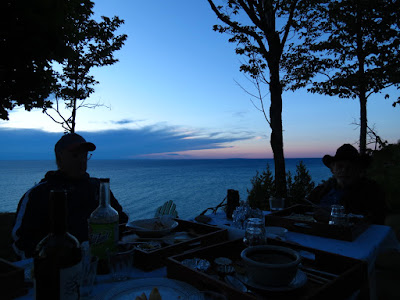No
jet lag this time around, as my travels were done from my own front porch.
There were no photographs or other illustrations in Tony Judt’s scholarly study
of Socialism in Provence 1877-1914, and yet, at the same time my brain was
working overtime to take in his arguments and evidence, it was also picturing
scenes from southern France – along with, I must admit, my grandparents’ modest
little “farmette” (they called it that) in Ohio in the 1950s and today’s
Leelanau orchards and vineyards and CSAs.
One
of Judt’s quarrels with research previous to his in French social and political
history was a tendency of researchers to lump regions and classes into large
homogenous groups and make sweeping generalizations based on a composite
portrait thus drawn of the populace. An area might be called agricultural, and
a certain percentage of the population identified as peasants, and from that
the researcher would assume conservatism and little active interest in
politics.
Yet
the difference between an isolated mountain hamlet (we ventured up a terrifying
road to explore one in the Auvergne in 2000) and a bustling country village
connected to other villages and towns by good roads was enormous in the time
period Judt was studying. Moreover – as was true with my grandfather and as is
true of many Leelanau farmers today – those working the land were not always
themselves landless. They could be and often were owners of small property,
working others’ land, as well as their own, or working in a small manufactory
by day and on their land in the evenings (this was my grandfather’s pattern),
or migrating from place to place with the seasons, following available work, or
working part-time in the fields and part-time at other jobs. Artisanal workers
and farm workers, laborers for others and property owners – these were not
mutually exclusive categories. Judt found that while conservatism did reign in
poor, remote areas, peasants on better land in the Var region, particularly
farmers who actually owned property, were more likely to support socialist
politics and programs. They saw collectivism as their best hope for being able
to continue living on and working the land, despite bad crop years and market
challenges from the larger world.
What
impressed me most was the difficulty of categorizing the ways in which people
earned their livelihoods. There was my grandfather, working in the casket
factory by day and tending his raspberry patch and vegetable gardens and fruit
trees in the evenings. There are farmers here in Leelanau who also work office
jobs or hold political posts or teach school in the winter. I own a small
business, and yet one fall I was among the county’s orchard workers, picking
apples for a local grower. This has been the truth of country living for a long
time, all over the world.
Another
nonfiction book I mentioned here recently, Self-Theories: Their Role in
Motivation, Personality, and Development, excited me greatly, and yet when I showed it
to a very well-educated friend, with interests far beyond his own field, he
laughed and said he would never have picked up a book with that title and
cover, never imagined that it could be interesting, much less (as I found it)
compelling, thrilling and inspiring. Here is what I sent him and another
friend, by e-mail, under the subject heading “This book just keeps getting
better and better,” when I was only halfway through the book:
It was published in 2000 by Psychology Press, an imprint of the Taylor & Francis Group, as part of a series called ESSAYS IN SOCIAL PSYCHOLOGY, so I'm talking about a book that is already 16 years old. One of the author's findings is that "we can influence students' theories [about themselves and their intelligence]. Although students came to our study with their own theories, what we told them had a clear impact. This means that people's theories of intelligence are malleable." So students who initially believe their intelligence is fixed can come to believe they can increase it, and this means they will be willing to take on challenges they would otherwise avoid. They can learn to learn! The author carefully says that the studies do not show such changes in belief to be permanent, but the initial belief wasn't permanent, either. Human beings can learn, not simply through trial and error, but by coming to believe they have the capacity to grow.
She calls the two theories "entity" and "incremental." Entity theories think of intelligence as a fixed trait; incremental theorists (these "theorists" are all of us, at every age of life!) think of intelligence as knowledge and skill, something that can be cultivated and improved. The entity theorists are performance-oriented, and when they "fail," they fall into despair and helplessness, because to them failure is a sign that they are not smart, after all. Incremental theorists have a very different view of failure, seeing it as an opportunity to learn, to employ new strategies, to try harder or focus differently, etc.
She doesn't stop there. She goes on to see if success and failure in relationships, and responses to perceived setbacks in relationships, follow the same pattern. She finds that they do. And then (I'm as yet only halfway through the book, and there are many, many studies conducted and cited), she finds that entity and incremental theorists not only judge themselves differently but judge others very differently, also. Entity theorists are quick to judge a person's character on the basis of a single action, but the author stresses that these quick judgments are not "impulsive," but "seem to grow out of a belief in character as a unitary thing that permeates virtually all actions and displays itself with great consistency."
The really great thing is that students in a classroom can, with appropriate readings, change from entity to incremental theorists. The author does not know if the change in belief would be long-lasting [results of research do not preclude but do not establish such a conclusion], but imagine retraining the thinking of people who work in prisons to believe that prisoners can learn and become better, more self-aware people!
My
excitement continued through to the last page of the book.
Similar
to the way Tony Judt, in Part III of his study, extrapolated his findings to
say something about socialism in France in general, Dweck takes her findings
(about how people’s self-theories affect the way they view success and failure
and influence responses to failure and challenges) and carries those into a
larger theory of motivation and personality. In Chapter 18 she surveys other
theories of personality and motivation. “Trait theories,” she tells us, are all
about description but offer little in the way of explanation. They are
particularly weak when it comes to explaining change. Not surprising, as Dweck
notes: “In fact, many trait theorists don’t really believe much in personal
change....” (This was my objection to the popular Please Understand Me and the Meyer-Briggs
personality type test.)
“Motive
theories” (she cites various in the group, but I am omitting the lists) leave
out anything to do with goals, beliefs, or cognitions. Both biological theories
and Freudian theories come in for criticism. Of course we inherit certain
temperaments, she acknowledges, but “temperament is not destiny,” and
biological theories “don’t look at adaptive functioning.” As for Freud, his
theory left no room for impetus toward growth, ignored goals specific to a
particular self, and posited all achievement as the result of defenses.
Growth,
goals, beliefs – in Dweck’s theory, these are central, with the meaning given
by the individual the most important factor in motivation, regardless of words
used in explanations. Some “entity theorist” learners may believe luck is a
factor but see luck not as unpredictable but as a feature of personality they
either have or lack, just as they see ability.
In
her final chapter, Dweck addresses questions and objections to her picture of
human personality and motivation. One question is posed as follows: “Isn’t It
Naive to Believe that Everyone Has the Potential to Change?” Excellent
question! Here, in part, is Carol Dweck’s response:
...I have not tried to argue that anyone can become Albert Einstein or Mother Theresa, but I have tried to argue that we do not know what anyone’s future potential is from their current behavior. We never know exactly what someone is capable of with the right support from the environment and with the right degree of personal motivation or commitment. ... The danger of the entity theory is not so much that it argues for human limitation, but that it suggests we can know people’s limitations so quickly and then grants them so little potential for growth. I believe that people and society gain a great deal when we search for ways to help people realize their potential instead of labeling or punishing them when they do not.
Children
can become “smarter” and more successful, Dweck has shown, when they
incorporate into their belief system the idea that “failure” is an opportunity
for learning and growth, not a sign of stupidity or badness. People who take on
this new belief about themselves can also improve their personal relationships,
no longer seeing setbacks as signals to give up. And everyone can see others
differently, too – as capable of change and improvement.
Imagine!
Imagine an electorate and a justice system, not only schools, believing in the
possibility of personal growth. Imagine not writing off others (or allowing
oneself to be written off) with “He can’t help it. It’s the way he is.” Being
shy does not mean one must be paralyzed by shyness. That’s just one example.
And
it is true at any age. I’ll let the author have the last word:
Some years ago, as I reached one of the landmark ages, I asked myself what I would like to be able to say at the end of my life, and it was this: I want to be able to say that I kept my eyes open, faced my issues, and made wholehearted commitments to things I valued. I did not want to be haunted by a litany of regrets or left with a bundle of potentialities that were never realized. As adults in this society our mission is to equip the next generations with the tools they need to live a life of growth and contribution. Can we make the commitment to help them become smarter than we were?















































































